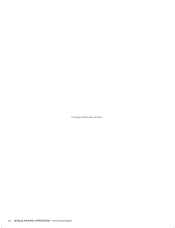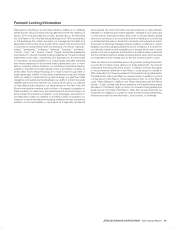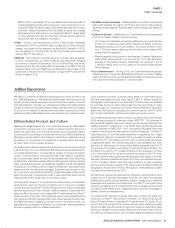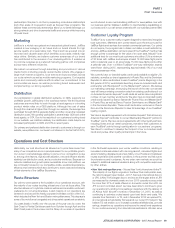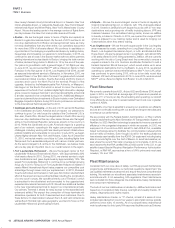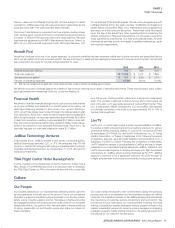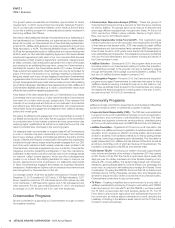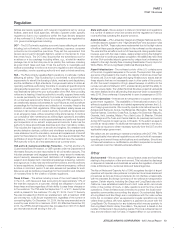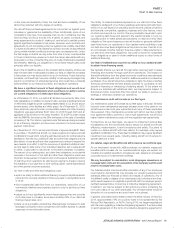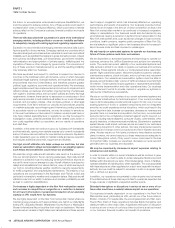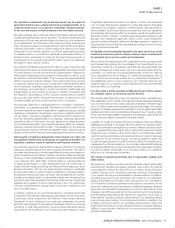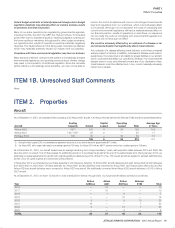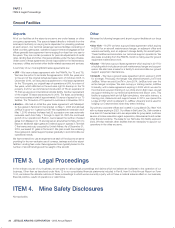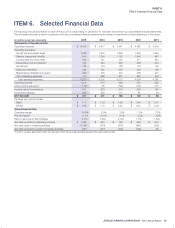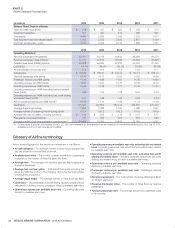JetBlue Airlines 2015 Annual Report Download - page 18
Download and view the complete annual report
Please find page 18 of the 2015 JetBlue Airlines annual report below. You can navigate through the pages in the report by either clicking on the pages listed below, or by using the keyword search tool below to find specific information within the annual report.
JETBLUE AIRWAYS CORPORATION-2015Annual Report14
PART I
ITEM1ARisk Factors
We use our JetBlue Sustainability program on www.jetblue.com/green/ to
educate our customers and Crewmembers about environmental issues
and to inform the public about our environmental protection initiatives.
Our most recent corporate sustainability report for 2015 is available on
our website and addresses our environmental programs, including those
aimed at curbing greenhouse emissions, our recycling efforts and our
focus on corporate social responsibility.
Foreign Ownership – Under federal law and DOT regulations, we must
be controlled by U.S. citizens. In this regard, our president and at least
two-thirds of our board of directors must be U.S. citizens. Further, no
more than 24.99% of our outstanding common stock may be voted by
non-U.S. citizens. We believe we are currently in compliance with these
ownership provisions.
Other Regulations – All airlines are subject to certain provisions of
the Communications Act of 1934 due to their extensive use of radio
and other communication facilities. They are also required to obtain an
aeronautical radio license from the FCC. To the extent we are subject
to FCC requirements, we take all necessary steps to comply with those
requirements.
Our labor relations are covered under Title II of the Railway Labor Act of
1926 and are subject to the jurisdiction of the NMB. In addition, during
periods of fuel scarcity, access to aircraft fuel may be subject to federal
allocation regulations.
Civil Reserve Air Fleet – We are a participant in the Civil Reserve Air
Fleet Program, which permits the U.S. Department of Defense to utilize
our aircraft during national emergencies when the need for military airlift
exceeds the capability of military aircraft. By participating in this program,
we are eligible to bid on and be awarded peacetime airlift contracts with
the military.
Insurance
We carry insurance of types customary in the airline industry and at amounts
deemed adequate to protect us and our property as well as comply with
both federal regulations and certain credit and lease agreements. As a result
of the terrorist attacks of September 11, 2001, aviation insurers significantly
reduced the amount of insurance coverage available to commercial airlines
for liability to persons other than employees or passengers for claims
resulting from acts of terrorism, war or similar events. This is known as war
risk coverage. At the same time, these insurers significantly increased the
premiums for aviation insurance in general. The U.S. government agreed
to provide commercial war-risk insurance for U.S. based airlines, covering
losses to employees, passengers, third parties and aircraft. Prior to the
end of U.S. government war-risk insurance coverage, JetBlue obtained
comparable coverage in the commercial market starting in 2014 as part
of our overall hull and liability insurance coverage.
Where You Can Find Other Information
Our website is www.jetblue.com. Information contained on our website is
not part of this Report. Information we furnish or file with the SEC, including
our Annual Reports on Form 10-K, Quarterly Reports on Form 10-Q, Current
Reports on Form 8-K and any amendments to or exhibits included in these
reports are available for download, free of charge, on our website soon after
such reports are filed with or furnished to the SEC. Our SEC filings, including
exhibits filed therewith, are also available at the SEC’s website at www.sec.
gov. You may obtain and copy any document we furnish or file with the
SEC at the SEC’s public reference room at 100 F Street, NE, Room 1580,
Washington, D.C. 20549. You may obtain information on the operation of
the SEC’s public reference facilities by calling the SEC at 1-800-SEC-0330.
You may request copies of these documents, upon payment of a duplicating
fee, by writing to the SEC at its principal office at 100 F Street, NE, Room
1580, Washington, D.C. 20549.
ITEM1A. Risk Factors
Risks Related to JetBlue
We operate in an extremely competitive industry.
The domestic airline industry is characterized by low profit margins, high
fixed costs and significant price competition in an increasingly concentrated
competitive field. We currently compete with other airlines on all of our routes.
Most of our competitors are larger and have greater financial resources
and name recognition than we do. Following our entry into new markets
or expansion of existing markets, some of our competitors have chosen
to add service or engage in extensive price competition. Unanticipated
shortfalls in expected revenues as a result of price competition or in the
number of passengers carried would negatively impact our financial results
and harm our business. The extremely competitive nature of the airline
industry could prevent us from attaining the level of passenger traffic or
maintaining the level of fares required to maintain profitable operations in
new and existing markets and could impede our profitable growth strategy,
which would harm our business.
Furthermore, there have been numerous mergers and acquisitions within
the airline industry including the combinations of American Airlines and US
Airways, United Airlines and Continental Airlines, and Southwest Airlines
and AirTran Airways. The industry composition may continue to change.
Any business combination could significantly alter industry conditions
and competition within the airline industry and could cause fares of our
competitors to be reduced. Additionally, if a traditional network airline
were to fully develop a low cost structure, or if we were to experience
increased competition from low cost carriers, our business could be
materially adversely affected.
Our business is highly dependent on the availability of fuel and fuel is
subject to price volatility.
Our results of operations are heavily impacted by the price and availability
of fuel. Fuel costs comprise a substantial portion of our total operating
expenses. Historically, fuel costs have been subject to wide price fluctuations
based on geopolitical factors as well as supply and demand. The availability
of fuel is not only dependent on crude oil but also on refining capacity.
When even a small amount of the domestic or global oil refining capacity
becomes unavailable, supply shortages can result for extended periods of
time. The availability of fuel is also affected by demand for home heating
oil, gasoline and other petroleum products, as well as crude oil reserves,
dependence on foreign imports of crude oil and potential hostilities in
oil producing areas of the world. Because of the effects of these factors


